Graphene: Marketing Hype or The Future?
by Mike CardenasIn a world where everything seems to be ceramic this and ceramic that, it was bound to happen, a new type of coating to change the proverbial game. Graphene is the newest element to hit the detailing periodic table of elements. What is Graphene? And will this miracle material become the future of detailing?
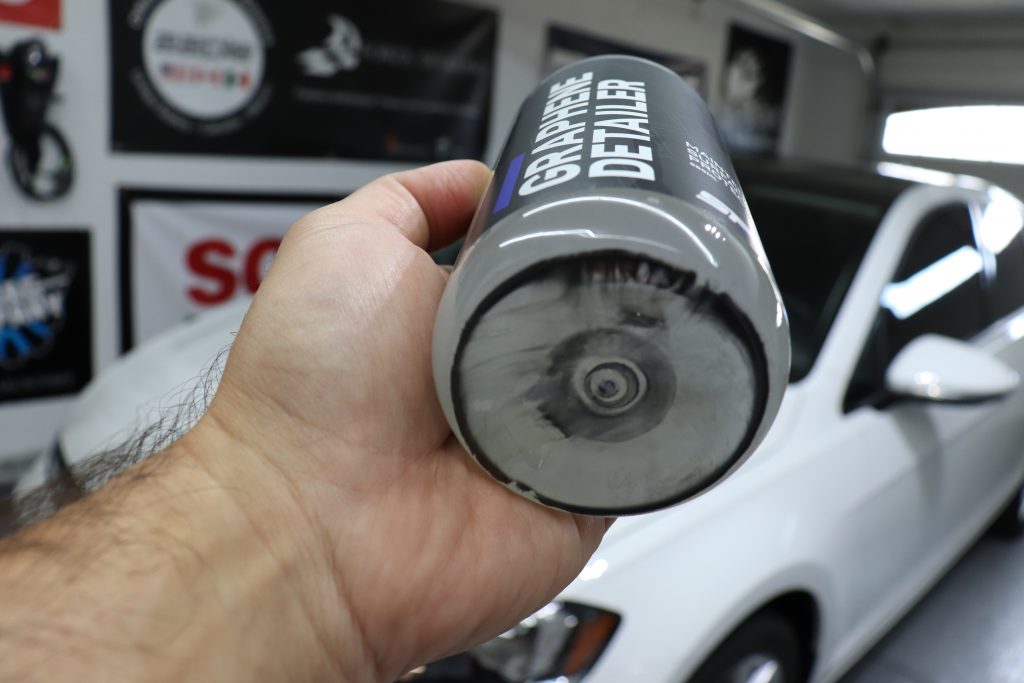
What is Graphene?
Graphene was discovered in 2004 by Andre Geim and Konstantin Novoselov from the University of Manchester in England. In 2010, both were awarded the Nobel Peace Prize in Physics for their discovery of Graphene. Graphene is one atom thick and is 200 times stronger than steel, transparent, flexible and extremely conductive. At one atom thickness, a single gram of Graphene can cover more than an entire football field. If that sounds amazing, imagine a thin sheet of it as thin as plastic cling wrap can withstand the weight of a large pickup truck on a pencil without penetrating the Graphene.
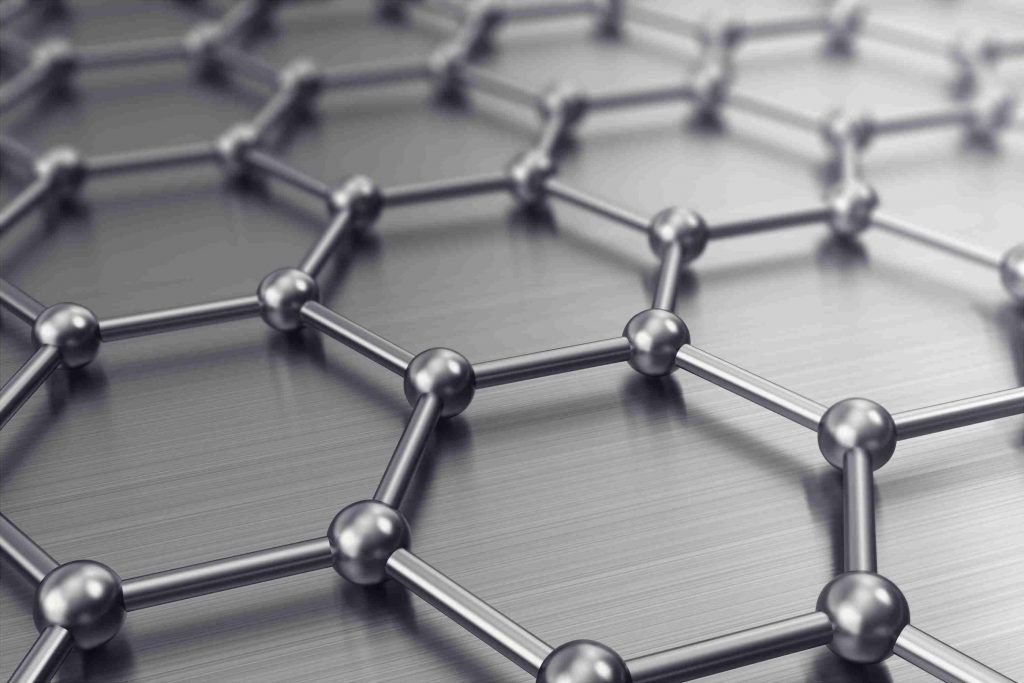
Structure of Graphene
With impressive characteristics like that, it’s no wonder that Graphene technology is on the radar of government agencies and most industries looking towards this technology to improve everything from batteries to textiles. Not to mention the military and space applications that Graphene would certainly impact. With so many governments and large global companies investing heavily into this remarkable material, how is it that detailing companies are already ahead?
Not all Graphene is the Same
Graphene a nanocarbon comes in various types, and it’s important to mention that not all Graphene has the ability to withstand that hypothetical elephant on a pencil without piercing it. In detailing, types such as Graphite Oxide, Graphene Oxide, or Reduced Graphene Oxide (rGO) are being commonly used. Many of these types are chemically similar but differ in terms of their structure and the process in which they are produced. Pristine Graphene is considered to be the bar by which most graphene types are measured by in terms of quality. The closer a graphene type is too pristine, the higher the quality. Although Pristine Graphene is realistically not required for use in detailing products and not very cost-effective.
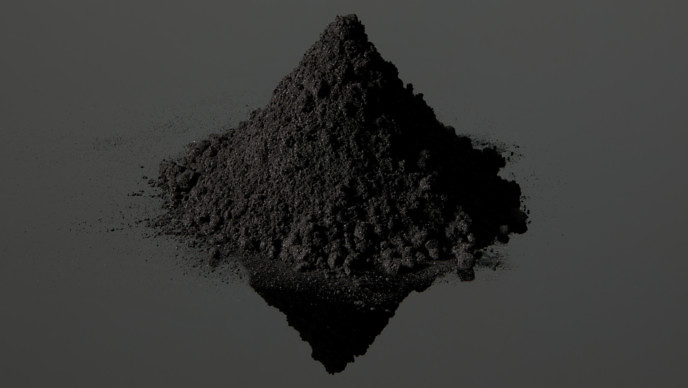
Graphene Powder
What are the Benefits of Graphene?
Since none of us are going to be looking into Graphene to build a better battery or strengthen golf clubs, let’s look at the benefits of Graphene for detailing. As a coating, Graphene is best known to help with the issues of water spotting and staining. With some companies claiming no water spotting or etching with their Graphene products. This is where some companies begin to rely on hype to market Graphene. The unique structure of Graphene is what gives it that ability to reduce water spotting (reduce being the keyword) utilizing an extremely minimal amount of rGO. Some companies that make Graphene coatings claim up to 50% less water spotting in comparison to ceramic coatings and this is more realistic than the marketing hype offered by some companies offering Graphene coatings.
On a molecular level, Graphene, or rGO to be exact has an ability to disperse heat and resist corrosion. When paired with certain solvents, rGO can strengthen and provide additional benefits to that solvent being paired with.
Marketing Hype?
Not surprisingly, the marketing for Graphene products has come out pretty strong out of the gate. Armed with new buzzwords, incredible claims, and other verbiage to help drive sales. Graphene has often been depicted by many as the replacement for ceramic coatings. Controversially, the technology has created such a buzz in detailing, that many to take an interest and have jumped on the Graphene train.
As detailing professionals and enthusiasts, we’ve all seen this scenario play out time and time again. A new something or other gets introduced and quickly makes a buzz. Only time will tell whether that product will prove itself in the real world or die quickly as a passing trend.
With Graphene, the technology is real. Graphene is a nanocarbon that exists and the technology is continually being further developed to be introduced into various products and processes in various industries. It does possess incredible abilities and characteristics that seem like something out of a comic book. 200 times stronger than steel, extremely lightweight, and virtually invisible, it’s these attributes that are founded in scientific fact but are marketed in a detailing product and alluding to these incredible attributes. Unfortunately, such marketing approaches have made Graphene products in detailing controversial and have caused many to discredit these products. It is not surprising that comments such as “they sprinkle some Graphene dust and coloring into an existing blend and now it’s a Graphene coating” or “They’re just infusing products with whatever the new trend of the week is” are pretty common as a result. I myself thought the same things prior to researching Graphene for this article.
Just like SiO2 coatings, Graphene coatings are also made up of various solvents, additives, binders, and agents. The comments that it’s just a sprinkle of Graphene is actually somewhat true. But we have to accept the facts of the technology, remember that Graphene is working at an atom’s thickness with 1 gram being able to cover the size of a football field.
For example, in a 50ml bottle of a Graphene coating, about .01 grams of rGO goes into that bottle. That’s incredibly less than a mere “sprinkle” than was is being described to discredit the hype. But this amount is used not for the reasons one may think, but mainly because most solvents will not suspend 1 gram of rGO in a coating without making the coating unusable. Making the coating way too sticky to use and basically making it a nightmare to install. There’s a fine balance that needs to be chemically addressed in order to make a functioning graphene product.
SiO2 Coatings vs Graphene: Comparisons & Similarities
With Graphene coatings, the water spotting and staining at less than 50% of traditional coatings is one of the claimed differences. The other difference is their price in comparison to ceramic coatings. A 50ml bottle of Graphene coating can be found starting as low as $50 USD retail. This is as a result that there are 7 known solvents that can suspend rGO (reduced graphene oxide). This makes it possible in some instances for Graphene coatings to be produced cheaper than SiO2 versions. For example, water is one of the carriers that can be used in a Graphene product. With an extremely small amount of rGO required, it really brings the cost to produce a Graphene coating significantly lower than that of a Sio2 coating.
Durability: Most Graphene coatings are offering from 2 years up to 4 years of durability. This is similar to most ceramic coatings.
Installation: Graphene coatings tend to be trickier to install than ceramic coatings. The viscosity of some Graphene coatings is higher than that of a Si02 coating, making it difficult to work with on the surface and level out. Because of the increased viscosity, some Graphene coatings are not easily absorbed by microfiber towels, making leveling difficult to get that until clear result.
Similarities: Hydrophobic properties, anti-corrosion, UV properties and gloss are some of the similarities. Although with Graphene, the thermal conductivity can be lower than that of SiO2 depending on the base components utilized. Inherently, some Graphene coatings tend to have a slicker feel in comparison to some ceramic coatings.
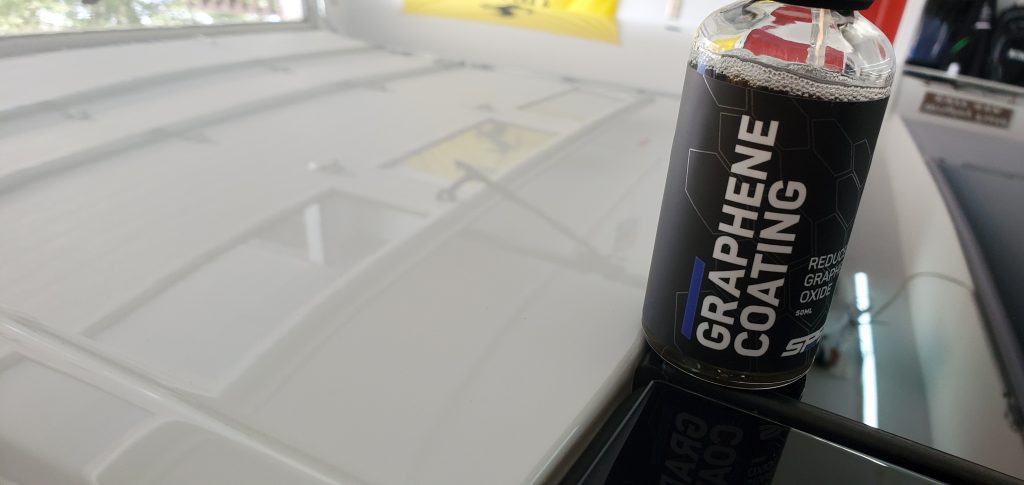
Graphene Coating by SPS
My Findings Using a Graphene Coating
As part of the research for this article, I sourced various Graphene coatings to try them in helping me understand more about this technology. I do consider myself to be pretty proficient in installing coatings as an installer of over 10 years, as a former sales rep for one of the largest coating companies, and lastly as the current President of 22ple North America. With that being said, I was totally unprepared for what I was going to experience with Graphene. What I found was that almost all of the Graphene coatings I tried were very different from each other. So much so, that the differences were extreme and not anything like the subtle differences we experience in the SiO2 realm.
In one instance, I smelled a Graphene maintenance spray that had a hint of cherry scent. That same company, when I smelled their Graphene coating, I was blown away! The scent of what I could only describe as the strongest ammonia I’ve ever smelled in my life had me gagging and coughing for several minutes. Some of the others had a familiar SiO2 scent to them, while some didn’t have a distinct scent at all.
In terms of color, that too was all over the place. Some were completely clear, some gray, and some really dark. Installation was also ranging from what could be described as the same for a SiO2 coating to feeling a bit sticky. The prices were from $49 for a 50ml bottle to around $75. SPS Coatings sent me their Graphene coating to test and their coating is a professional installer only, so I was not made privy to their price.
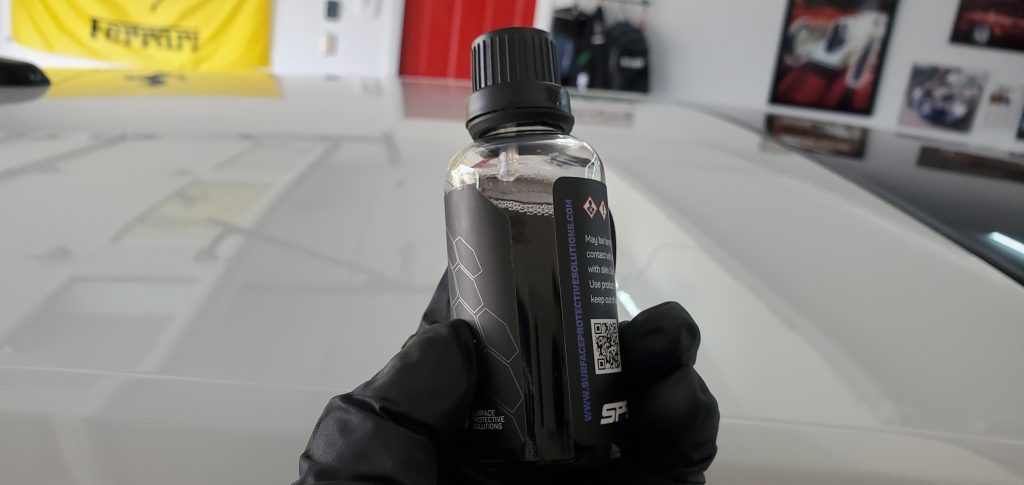
SPS Graphene Coating Color
Currently, on Graphene in coatings, it is completely unregulated. So there is no control as to what type of Graphene or quality of Graphene some of these companies are getting. This could be one of the many contributing factors as to the differences among Graphene coatings. With so many differences in one type of coating, I decided to compare two of the Graphene coatings against each other. My vehicle is coated in 22ple and so I could use the hood to compare against the two coatings on the roof. Brett Welzien, president at Surface Protective Solutions was very helpful in giving me information on their Graphene coatings.
Installation
As I installed both coatings on their respective side of the roof, The SPS Graphene Coating was as Brett Welzien described, “definitely a little different from a ceramic coating“. The coating had a unique scent that I was not familiar with from any coating I have previously used. The coating was tricky to level and so doing smaller sections was the way to go. Upon leveling, I immediately noticed that the surface felt really slick, almost like that of a waxed surface. Keep in mind, this is not a review of this product, but my experience in using this particular Graphene coating.
Installing what I will be calling “Graphene X” on the other side of the roof, instantly this was extremely different from the coating by SPS. The label read Graphene Coating, but it went on just like a traditional ceramic coating and smelled like a traditional coating. Another example of how different most Graphene coatings are from each other.
I let both coatings cure to their respective times and let this test go for 30 days after the cure time to see how they performed under real-world conditions. My vehicle spends its time outside during most days and evenings as my client’s vehicles always get stored inside. During this test, we had several rainy days in Indiana and add that to several frosty mornings and some birds that did their usual business.
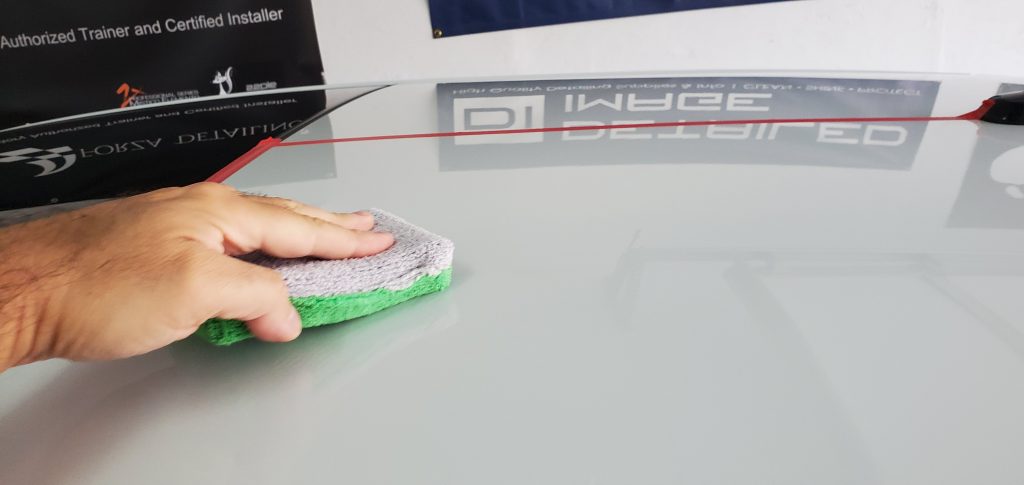
Installing “Graphene X”
As you can see from the picture below, both coatings bead differently. In terms of water spotting, the SPS did do about 50% less water spotting than the rest of the vehicle coated without Graphene. Amazingly, it was also about 50% less water spotting than the “Graphene X” coating. When I applied these coatings, it’s important to note that the “Graphene X” applicator did not harden at all and that the applicator used for SPS did harden somewhat but not by much. After being opened after 30 days, one had glass type shards around the bottle (SPS) and the other had a powder silica type residue.
Having lived with the coatings for over a month, I was very pleased with the performance of the SPS Graphene Coating. The others left much to be desired in my opinion. It’s worth mentioning that those products have a lot of marketing hype behind them in comparison to SPS, so it makes one wonder.
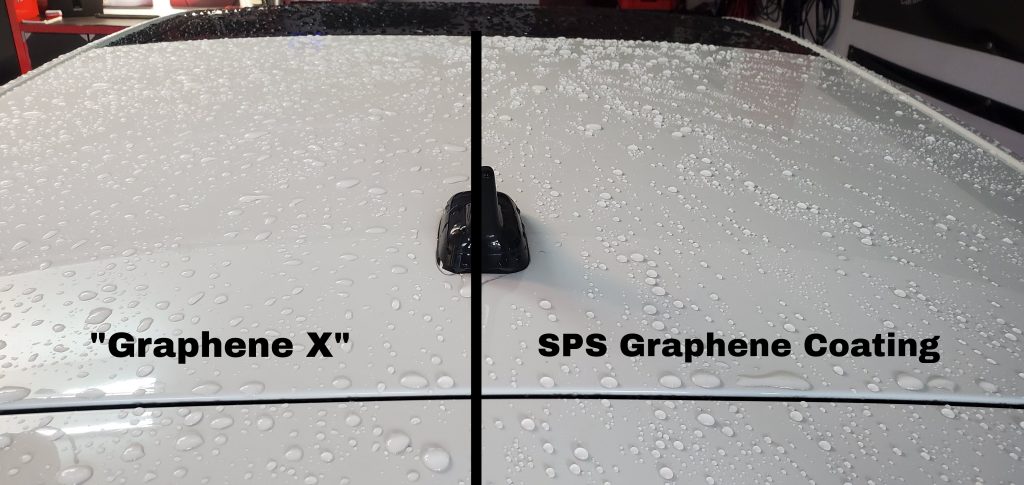
Beading: Graphene coating “X” compared to SPS Coatings
Closing Thoughts
Is Graphene the future or is it just marketing hype? After having used several different Graphene coatings and sprays, in my opinion it is a little of both to some degree. In my opinion, Graphene coatings are just another way of coating a vehicle, another flavor to add to the mix of detailing coatings. They do have some features like water-spotting reduction that make them a great choice for someone who has issues with water-spotting. But at the end of the day, they actually share more in common with traditional coatings than differences. It’s just another way to skin the cat as they say.
I often get asked, will they replace the traditional coating? In my professional opinion, I don’t see that happening anytime soon. The technology on Graphene is not there yet to blow the doors off the traditional coating to make it obsolete. As technology advances, perhaps it could reach a point in which it would surpass or make traditional coatings a thing of the past. In my opinion, we would have to start seeing tremendous advances in Graphene technology before we see that happen. Respectively, SiO2 coatings are also continually making new developments and improvements.
Like many products in detailing, Graphene products are not immune to the same quality issues we see with other products. You’re either getting a high-quality product that delivers as promised or junk that is nothing more than a money grab.
In my opinion, Graphene coatings and products are merely just another crayon to add to the box. Another color to help us paint what we want to paint. Not to replace a particular color, but to provide a different shade of it. Its up to us to decide whether or not Graphene products meet our particular needs and choose those products which live up to their marketing.



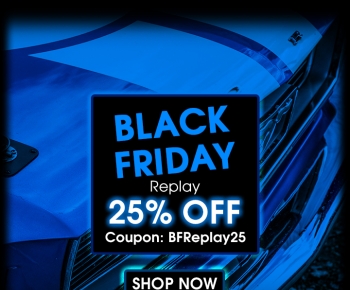




Great write up Mike. I have experimented with SPS and it is a nice coating to work with and like everything it has its pros and cons. Overall it is a good coating and it is a good start. But we shall see where the graphene market goes and if it does indeed stick around.
SPS Graphene is the “White Label” of ArtDeShine Nano Graphene Coating.
SPS now has it’s own unique formula as of a couple weeks ago.
Awesome write up as always Mike and very informative and accurate!
Yes, spot on Mike…thanks for keeping us in check.
Here is a nice video to review…
Thanks for the article! I appreciate the info.
Interesting write up, and thank you. I will be watching for now, after recently taking a dive into ceramic coating from wax.
Like the wire up very informative, but you left it one of the best coatings made and that’s the Adam’s Polishes advanced Graphene Coating it is in a class by itself and I’ve used coatings from many different companies, it’s easy to apply and even has a LED UV light as part of the kit to ensure you are applying it evenly and that you don’t miss any spots. Great kit, excellent coating! Great write up!